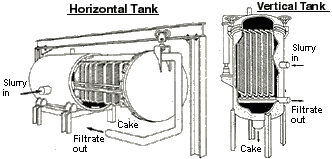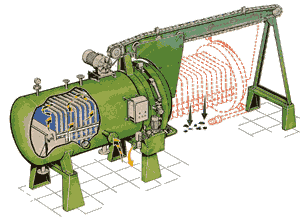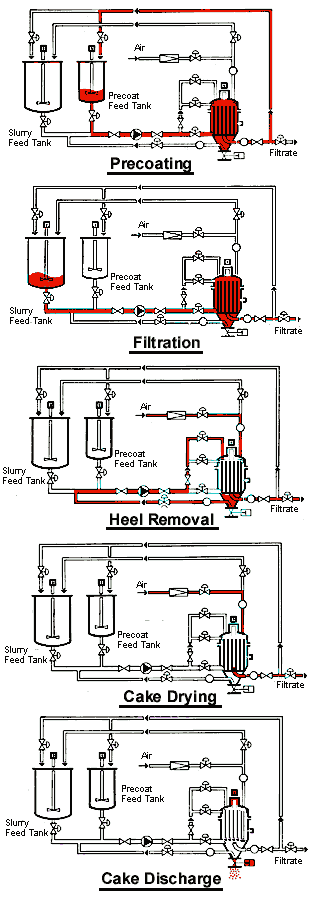
|
Click on the
thumbnail to maximize the image |
Vertical Pressure Leaf Filters are quite similar to the Horizontal Plate Filters except for the orientation of the filter elements which are vertical rather than horizontal. They are applied for the polishing slurries with very low solids content of 1-5% or for cake filtration with a solids concentration of 20-25%.
Just like the Horizontal Plate Filter the Vertical Leaf Filters are also very well suited for handling flammable, toxic and corrosive materials since they are autoclaved and designed for hazardous environments when high pressure and safe operation are required. Likewise, they may be readily jacketed for applications whenever hot or cold temperatures are to be preserved. These features are not possible on Filterpresses which require the opening of plates to the atmosphere and shifting them one by one to allow cake discharge at the end of each cycle.
The largest Leaf Filters in horizontal vessels have a filtration area of 300 m2 and vertical vessels 100 m2 both designed for an operating pressure of 6 bar (see below the section on The Vessel).
The Leaves
|
The slurry is pumped under pressure into a vessel that is fitted with a stack of vertical leaves that serve as filter elements. Each leaf has a centrally located neck at its bottom which is inserted into a manifold that collects the filtrate. The leaf is constructed with ribs on both sides to allow free flow of filtrate towards the neck and is covered with coarse mesh screens that support the finer woven metal screens or filter cloth that retain the cake. The space between the leaves may vary from 30-100 mm depending on the cake formation properties and the ability of the vacuum to hold a thick and heavy cake to the vertical leaf surface. The space is set by the filtrate necks of the leaves at the bottom end and with spacers at the top end brackets. For fast filtering slurries the space may be doubled by removing every second plate so consequently the cake space doubles but the filtration area is cut in half.
|
 |
There are two types of vessel configuration:
|
In most of the fine chemicals processes the leaves are fitted into vertical vessels whilst horizontal vessels are used in the heavier process industries such as the preparation of sulfur in phosphoric acid plants. The leaves inside horizontal tanks may be positioned either along the tank axis or perpendicular to the axis. In order to utilize the tank volume for maximum filtration area the width of the leaves is graduated so they fit to the circular contour of the tank. This also reduces the slurry heel volume that surrounds the leaves. The vessels are fitted with highly secured cake discharge openings to ensure safe sealing of the tank under pressure. The cake that accumulates on the leaves may be discharged as a wet thickened sludge or as a dry cake. For wet cakes the vessel will normally have a small outlet that is fitted with a valve whilst for dry cakes the opening is large and the closure locks up electrically or hydraulically with a bayonet wedge. The head cover of vertical vessels is often pivoted so that it is swung away to allow the upwards removal of the leaves in the stack. It is good practice to design a special rig that will support a leaf that is removed from the vessel. Special quick opening bolts are fitted around the cover so that tightness is secured during operation but enable easy opening when access to the stack is required.
|
 |
Cake Discharge

|
One of the advantages of the Vertical Leaf Filter when compared to the Horizontal Plate Filter is when cakes depart easily from the filtering medium. In such cases it is not necessary to incorporate means to assist discharge since gravity will release the cake and let it drop towards the discharge opening. For such cakes that do not discharge readily a special mechanism that vibrates the entire stack is incorporated and this will in most instances release the cake. However, with this method care must be taken so that the cake does not bridge between the two adjacent plates since this will impair cake discharge. There are instances when the cake is disposed to ponds or repulped for further treatment and in these cases special oscillating high impact jet headers sweep the medium surface and sluice the cake through the discharge outlet. These headers also serve to wash the filtering medium and dislodge particles that clog the metal screen or cloth. |
Vertical Leaf Filters are best selected in the following instances:
They should be selected with care:
When the cake is thick and heavy and the pressure is not sufficient to hold it on the leaf.
When coarse mesh screens are used the filtration step must be preceded with a precoat to retain cakes with fine particles. Precoating with a thin layer of diatomite or perlite is not a simple operation and should be avoided whenever possible.
Advantages
The cloth or woven mesh screens that cover the leaves of horizontal tanks may be accessed easily once the stack is pulled out of the vessel. This allows thorough washing of the medium with high impact jets manually in case that the cake bridges between the leaves. On vertical tanks the head cover must be unbolted and removed in order to access the leaf stack.
Mechanically simple since there are no complex sealing glands or bearings.
Disadvantages
The operation of a Vertical Pressure Leaf Filter is labor intensive and requires a complex manipulation of valves so present day installations are in most cases fully automated.
|
Precoating
The precoating stage is done only in the following cases:
Filtration Once the precoating stage is completed the process slurry is pumped into the filter, the forming cake is retained on the leaves and the filtrate flows to further processing. When the solids are fine and slow to filter a body-aid is added to the feed slurry in order to enhance cake permeability. However, it should be kept in mind that the addition of body-aid increases the solids concentration in the feed so it occupies additional volume between the leaves and increases the amount of cake for disposal. Likewise, for all those applications when the cake is the product, precoat and filter-aid may not be used since they mix and discharge together with the cake. Please refer to the section on Pressure Filters for further details on precoating and the addition of body-aid. Heel Removal Once the filtration cycle is completed air or gas is blown into the vessel and the slurry heel that surrounds the leaves is pushed and displaced downwards until it reaches the lowest part of the leaf stack. At this point the remaining heel slurry is evacuated back to the feed tank by a special dip pipe that is located at the very bottom of the vessel so that the vessel is empty from slurry.
Cake Drying The air then continues to pass through the cake until the captive moisture is reduced to a minimum and the cake is in practical terms considered to be dry.
Cake Discharge At this point the air pressure is released, the cake outlet is opened and the leaf stack is vibrated to discharge the cake. The cake outlet opening must be interlocked with a pressure sensor to avoid opening under pressure. On some filters the cloth or mesh screen may be backwashed with water after cake discharge to dislodge and remove any cake residue that adhered to the medium.
|
 |
The Vertical Pressure Leaf Filter requires attention on a regular basis to safety devices and automation features that accompany modern filters.
The space above the filter should have a hoisting device and sufficient headroom to lift each leaf and move it horizontally to a location adjacent to the filter tank. It is recommended to have a special rig that will hold the leaf for maintenance. Space must also be allocated for the cover which may be either hinged or removed.
The major components that require attention are: